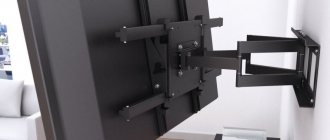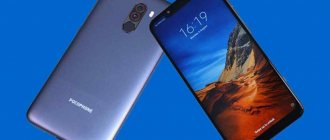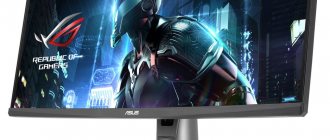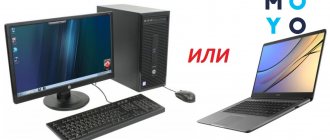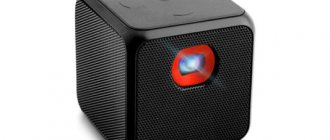TVs with curved screens differ from their analogues in their impressive cost and non-standard appearance. Why do you need such a TV? Are consumers really overpaying solely for original design?
A curved screen also affects the technical characteristics of the device: contrast, viewing angle, image realism, etc. However, how significant is the difference between such TVs and standard models? Let's find out now.
Samsung UE49KU6300
Features of curved screen TVs
Don't forget that curved screens are twice as thick as regular TVs. Such a device will look bad on the wall. To avoid excessive highlighting of the TV along the edges, the equipment must be placed in a pre-created niche.
The comfort zone is another feature that needs a few words about. If the distance from the viewing point to the screen is greater than the diagonal of the TV, then you will not be able to enjoy a high-quality image. The maximum immersion effect will only be if you are in the center and as close to the screen as possible.
Watching TV in a group also becomes noticeably more difficult. Because it is almost impossible to place everyone in the center. Part of the image is lost. The picture becomes too narrow. The distance to the near and far extreme points becomes even more noticeable.
Distortion is another feature common to concave screens. Non-linear distortion occurs when watching a curved TV if you are to the left of your comfort zone. The left side of the picture begins to be in profile.
Xiaomi Mi TV 4S
To objectively evaluate TV equipment, you need to understand the basic technical parameters. Curved and straight screens are significantly different. TVs should be evaluated through the prism of special criteria:
- Brightness. Modern TVs have no problems with this parameter, regardless of the screen type. Users will be able to adjust the brightness of the image;
- Screen resolution. This parameter determines the ratio of the number of pixels per unit area (vertical and horizontal). The higher the resolution, the better the quality of the picture. If the resolution of the video file and the screen match, the image will be perfect;
- Contrast. Indicates the difference in brightness in different areas of the TV screen: from the lightest to the darkest. Contrast can be static or dynamic in different areas of the picture;
- Viewing angle. Defines the maximum permissible angle to the screen plane at which the picture is not distorted. Ideally, this parameter should be 178 degrees;
- Response. Time of change of pixel state. The lower the response, the higher the image clarity. There will be no blur effect;
- Available interfaces. The TV must have everything it needs to sync with other devices;
- Diagonal. Measured in inches. The screen size is determined according to the distance from the viewing point to the screen. The optimal distance is approximately 2-3 diagonals of the TV screen.
Samsung UE40K6500BUX
To determine whether a curved TV is truly superior to a conventional device, compare them based on these criteria.
The idea of concave TVs from LG, Samsung, and Sony appeared quite a long time ago. Many companies have used this technology to produce movie screens. A curved screen allows you to solve several important problems:
- Correct transfer of images from the projector to the screen.
- The radius of perception increases for viewers close to the screen.
- Maximum immersion in viewing is ensured, since the person is as if under a dome.
These properties are clearly manifested during viewing in the cinema. However, they are also typical for small curved TVs. Therefore, at home, you can also achieve maximum immersion and optimal radius of perception.
Top 5 best curved screen TV models
Due to the high popularity of the technology, TVs with curved displays began to appear in the assortment of leading companies. And if you make the TOP 5 best models, it will include the following devices:
- Samsung UE40KU6300U is a 40-inch TV with a 16:9 aspect ratio, which is distinguished by natural color reproduction, a large brightness reserve and extensive functionality. The model comes with a built-in TV tuner and is equipped with advanced stereo speakers, which allows it to be classified as a full-fledged home theater. Optional support for Wi-Fi and Smart TV systems. The cost of the model on the Russian market is 39,400 rubles.
- Philips 55PUS8700. In addition to the curved matrix, this 55-inch TV has a powerful sound system of 5 speakers and one subwoofer. The liquid crystal panel received an increased brightness reserve and an innovative Ambilight backlighting system, which gives the picture additional realism. The TV has support for Smart TV and synchronization with external devices via Wi-Fi. The model reproduces any media formats, which improves the viewing experience. To purchase a TV you will have to pay from 95 thousand rubles.
- LG OLED65C6V. The TV is built on OLED technology, and its matrix diagonal is 65 inches. The strength of the device is considered to be high detail, as well as support for converting 2D images to 3D. The presence effect is provided by 4 stereo speakers. The manufacturer has provided HDMI ports and a Wi-Fi interface for convenient and quick interaction with third-party devices. The operating system is WebOS, which turns the TV into a powerful multimedia tool with Internet access.
- Xiaomi Mi TV UHD 4S 55. The Xiaomi Mi TV 4s 55″ has a 55-inch screen with a resolution of 3840x2160, 3 USB ports and support for the Smart TV system. Optional support is provided for HDR 10, Internet browser, Facebook, Skype, Megogo, YouTube and others. Interesting features include screen recording, voice control and gesture control. The device runs on Android TV.
- Kivi 55UC50GU is a 55-inch TV with a resolution of 3840x2160. It is a curved device that is sold at an affordable price and is not inferior to many models from leading brands. The TV has HDR support, and the brightness reserve is 450 cd/m2.
Advantages and disadvantages of curved TVs
Let's start with aesthetics. Curved models look more modern compared to regular flat TVs. However, there are several pitfalls. Firstly, they are more bulky and voluminous, precisely because of their unusual design. Secondly, they are very difficult to hang on the wall. The process itself is not difficult, but problems will arise with selecting the optimal position.
Samsung UE55NU7500UXUA
By analyzing the pros and cons of a curved screen TV, you can decide whether to purchase such a device. First, let's list the positive qualities:
- glare is reflected well;
- visual perception of the screen increases;
- increased field of view;
- excellent contrast;
- appearance.
The bends of a curved TV also have a negative impact. Main disadvantages:
- When viewing, you need to be in your comfort zone, otherwise the image will be distorted. This is inconvenient for group viewing;
- the overall thickness of the device increases, as a result of which the TV becomes too bulky;
- the effect of curvature appears;
- It is very difficult to fit such a TV into the interior of the room;
- high price.
The cost of maintaining concave TVs is another notable disadvantage. This is explained by the difficulties that arise during the disassembly and subsequent assembly of equipment. Curved TVs are equipped with conventional flat panels. Their deformation is carried out artificially. Therefore, the matrix is constantly in a state of increased tension.
Samsung HU8500
To ensure that the component bends in accordance with the shape of the TV, manufacturers noticeably reduce the thickness of the protective coating. Because of this, the module becomes more fragile. The likelihood of mechanical defects increases.
Avoid marketing gimmicks. Weigh the pros and cons. Having compared the advantages and disadvantages, you will come to the conclusion that, in addition to their beautiful appearance, curved TVs do not have any real technical superiority. For family viewing, this is far from the best solution.
Such models are more suitable for various demonstrations, presentations, and exhibitions. For regular viewing, it is better to buy a flat-screen TV. Direct screens are also not without their drawbacks, but they are intended specifically for home use.
Price/benefit and our final word
As you've probably guessed, we're not fans of curved screens. For the most part, this technology creates more problems than benefits, and several advantages do not cover up the much larger number of objective disadvantages. In addition, such TVs are much more expensive than their flat-panel counterparts. Given the weaknesses of the curvature, we're not sure the price for these TVs is justified.
On the other hand, fans of manufacturers like Samsung, LG and Panasonic have little choice if they want to buy a flagship, since all the best models come with curved screens.
This factor, in part, creates a false impression among potential buyers that the best TVs are those with curved screens. They see that the manufacturer has announced the next flagship, and this flagship has a curved screen, and the consumer begins to think that curvature is cool.
To summarize, I would like to say that the curved screen does not do as much for the TV as we would like, not providing the user with what he expected when buying a curved TV. Yes, it slightly improves the viewing experience, but just a little, and only on large screens. But if you are fascinated by the appearance of such TVs, or just want to be trendy, then go ahead.
17 Sep 2021 S.Denchuk 32639
Share this post
Discussion: there is 1 comment
- Ivan:
10/04/2016 at 10:54Bent TVs certainly look cool, you can’t argue with that!
Answer
Does diagonal size matter?
A very controversial issue. Manufacturers of curved screen TVs claim that size is the determining parameter. It is this characteristic that they justify the high cost of equipment.
QLed Samsung QE 55 Q8C
In theory, a curved screen will provide the maximum level of immersion during the viewing process. The noticeable amount of screen space will be expanded. Add to this the high resolution. Therefore, in theory, a large diagonal curved screen should provide a completely immersive viewing experience and excellent depth.
In practice the situation is different. The newest model with a screen size of 60 inches will not significantly surpass a similar device with a flat display. The actual diagonal of a curved screen is approximately 1 inch larger than a flat screen.
The appearance of additional space helps to increase the field of vision. But this is not a significant difference. Field of view is the degree of viewing while watching TV at a distance of 2.4 meters from the screen. The curved screen will provide an increase in field of view by approximately 1 degree compared to a conventional flat TV.
In fact, immersion and diagonal size do not have a significant impact. You need to calculate the screen size in accordance with the distance from the viewing point to the screen. Therefore, in rooms with a small square footage there is no point in buying devices with a screen diagonal of 60-80 inches. The optimal choice is a distance equal to approximately 2-3 diagonals of the TV screen.
What are the benefits of a curved TV screen?
So, what are the revolutionary features of a curved screen TV, and the pros and cons of this new technology? Let's start with the advantages.
- The effect of immersion in the plot.
Thanks to the concavity of the panel, the so-called “cinema effect” actually occurs, when not only a person’s direct vision is activated, but also peripheral vision.
- Wider viewing angles.
This parameter is critical for LCD TVs, which are not advisable to watch at sharp angles, since the brightness and color saturation of individual areas of the image are noticeably reduced. The curved panel seems to surround the viewer, so in fact he looks at all its sections strictly straight.
- Anti-glare properties.
Theoretically, the revolutionary shaped screen produces less glare, as its curvature scatters side light more effectively. But under certain conditions, it can, like a concave mirror, direct scattered rays exactly to the point where the viewer is located.
- Image depth.
Marketers claim that the image on a concave TV, even without 3D support, appears three-dimensional. Physiologists confirm the possibility of a sensation of depth, but it is so insignificant that most viewers simply do not notice it.
- Aesthetic appeal.
Curved TV receivers are still exotic, so they additionally perform image functions, automatically raising the status of their owner.
Now a little about the disadvantages.
- Geometric distortions.
Almost all viewers note the presence of the so-called “bow tie” effect, in which the image near the side edges of a curved TV appears somewhat stretched in comparison with the central part of the screen. Also, many people notice a slight curvature of long straight lines or a running text line.
- High price.
Models with flat panels today cost about 30% less than curved ones with equal functionality and manufacturability.
- Problems with wall mounting.
Given the unusual shape of the screen, users often encounter difficulties when hanging them on walls. Although manufacturing companies produce special mounts, they still recommend installation on horizontal surfaces. In addition, a curved TV on a flat wall does not look entirely organic.
As you can see, models of the original form have more advantages. However, an affirmative answer to the question of whether it is worth buying a TV with a curved screen is possible only if several prerequisites are met:
- Only one viewer will be able to fully enjoy all its advantages;
- It should be located within a special comfort zone, the parameters of which depend on the diagonal size and screen resolution.
How high should you hang a TV on the wall?
How to choose a TV diagonal
What is the difference between LED and OLED TVs?
Reflection and viewing angle
A curved TV will reduce contrast on the sides of the screen. Provided that the viewer is located as close as possible to the source of viewing. Modern video file formats will smooth out the contrast on the sides.
Samsung UE49KS7500U
There are very few comfortable viewing points, so watching TV in a large group will be very uncomfortable. However, this drawback is typical for both straight and concave screens. There are no significant differences between these TVs. The declared advantages of curved TV manufacturers are visible only on paper.
Optical distortion is another important point. The sensor sensors of the matrix, which provide focusing, are located throughout the plane. Therefore, video files are initially designed to be viewed on a flat surface. When a curved surface is involved, the picture may become distorted. This criterion once again confirms that ordinary flat TVs are in no way inferior to curved ones.
During viewing, the sun's rays fall on the screen. The curvature of the plane is a catalyst for changing the angle of refraction of rays, so the amount of glare is reduced. This effect is especially noticeable in rooms with bright lighting. The further the user is from the screen, the more the intensity of the glow of foreign objects on the screen will decrease.
Samsung SUHD UE65JS9000TXRU
Visual increase
A curved TV screen will provide a visual magnification of the image. Even the screen itself will look more voluminous compared to conventional flat displays. However, the effect directly depends on the distance between the screen and the viewing point. The further away the viewer is, the lower the visual perception of screen width. This advantage is also relative.
Visual enlargement is not only an advantage, but at the same time a disadvantage. Due to its design, a curved TV becomes too bulky. Therefore, difficulties arise when placing the device on the wall. It’s easier to put such a TV on a special stand.
Sony KD-50SD8005
Immersive viewing
Curved TVs provide the most immersive viewing experience. This advantage is determined by the design of the device. This is why cinemas also install screens of this shape. The image looks as natural and realistic as possible. This effect can be achieved due to the fact that the screen bends. The image “comes out” a little forward, literally flowing around the viewer. Although regular TVs are not much inferior to curved models in this regard.
The first reaction of viewers who watched the film on a curved TV was delight. They think they saw a three-dimensional image without 3D glasses. Although in fact this is an ordinary picture in 2D format. This effect occurs because the curved edges increase the visual perception of depth. Samsung enhances this effect by automatically adjusting the contrast of different parts of the picture.
Samsung QE75Q8С

